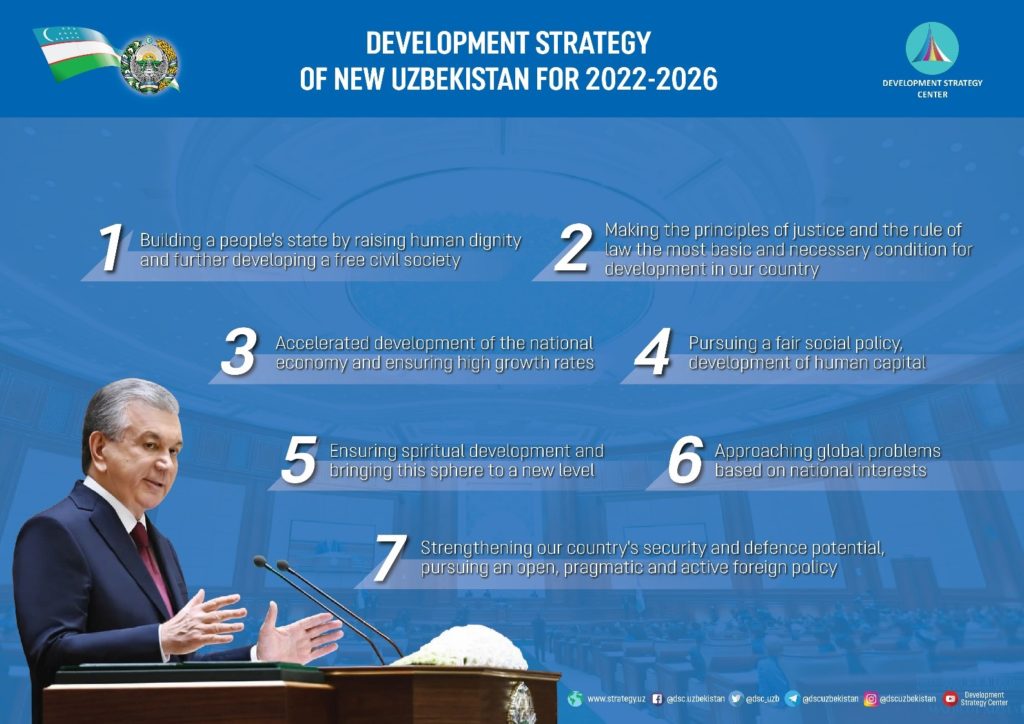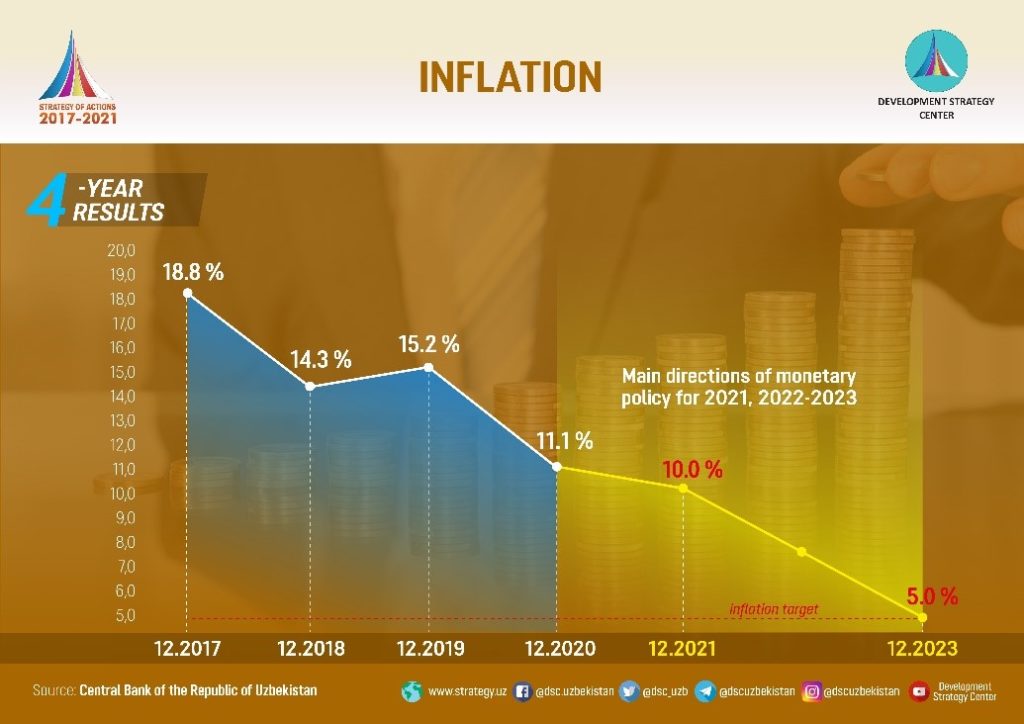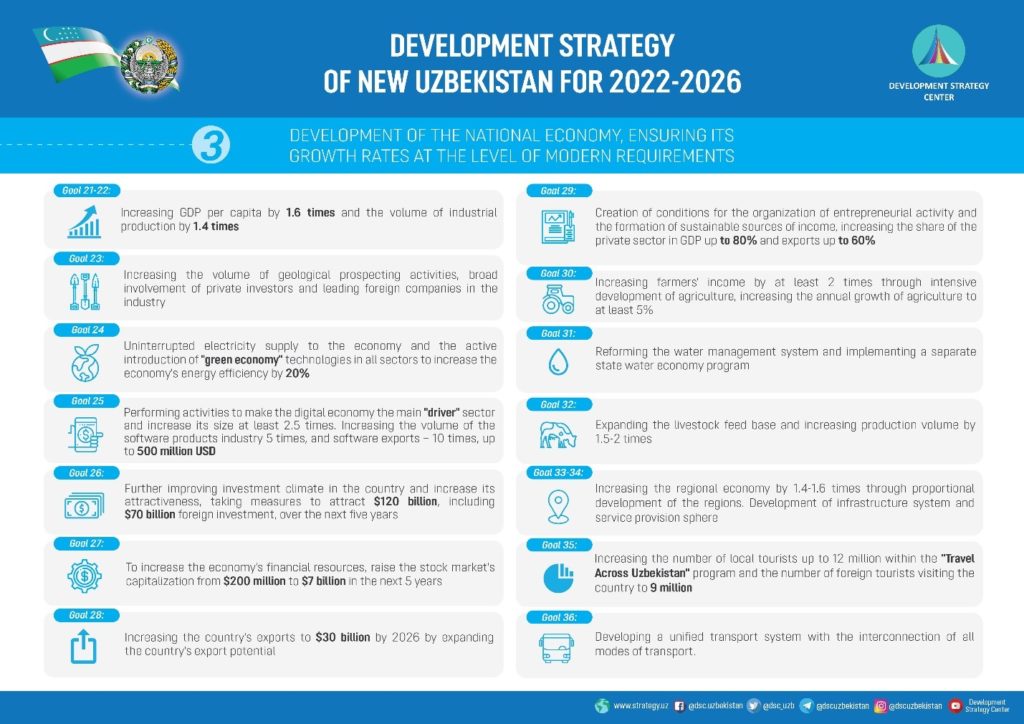
After broad public discussions, Uzbekistan has adopted its five-year Development Strategy for 2022-2026. It consists of seven priority directions and one hundred goals Uzbekistan is willing to achieve within five years. This strategic document will serve Uzbekistan as a baseline for further reforms in all spheres.
The Strategy foresees the implementation of various measures that should create the basis for joining a number of “states with the above-average income”.
The country has identified target goals in concrete numbers and introduced the mechanisms of reaching those goals. Further economic liberalisation, privatisation in most spheres, competition, elimination of monopolisation, the attraction of more foreign investment, price stabilisation, support of the development of “driver spheres of the economy,” and decentralisation that gives more authority to the regions are among many other priorities identified in the Development Strategy for 2022-2026.
For instance, a target goal for the country is a 1.6-time increase in the GDP per capita in the next five years and the per capita income to reach $4,000 by 2030 by ensuring stable high growth rates in all sectors of the economy, including energy, industry, machinery, mining, agriculture and others. Another important aim is to ensure macroeconomic stability and gradually reduce the annual inflation rate to 5 per cent by 2023. This year, the state intends to decrease the inflation rate to 9 per cent.

Looking at the proposed industrial policy reforms outlined, one can see that the country will continue ensuring the stability of the national economy and increasing the share of industry in GDP by increasing the volume of industrial production by 40 per cent. For that, priority areas have been identified, and each consists of its target numbers. These goals include implementing large investment projects in metallurgy, such as an increase in the production volumes of gold by 26 per cent and silver by 42 per cent, and a 2-fold increase in copper and ferrous metal products. Production in the chemical industry will be worth $2 billion by developing the chemical and gas chemical industries and bringing the level of natural gas processing from 8 to 20 per cent. Additionally, the plan calls for double the production of building materials, growth in the leather and footwear industry by 3.2 times its current size, a three times increase in pharmaceutical industry products, and furniture products growing by 2.8 times.
All of these plans require an uninterrupted supply of electricity to the economy. Therefore, in addition to other planned measures, the active introduction of green technologies in all areas, an increase in energy efficiency by 20 per cent, and a reduction in emissions of harmful gases into the atmosphere by 10 per cent are proposed. For example, by 2026, there is a planned increase in electricity production by an additional 40 billion kW/h, bringing the total to 110 billion kW/h. Furthermore, the government intends to save about 3 billion cubic meters of natural gas by bringing the share of renewable energy sources up to 25 per cent of energy production by 2026. In conjunction with this, reducing the emission of harmful gases into the atmosphere in the amount of 8 million tons is also a priority.
Another important goal is the transformation of the digital economy into the core “driver” sphere of the economy. Implementing work aimed at increasing the digital economy’s volume by at least 2.5 times is also a goal to strengthen the country’s potential in this new sphere.
Planned reforms need a constant flow of investments that require an appropriate investment environment and the rule of law. Accordingly, taking measures to attract the necessary $120 billion over the next five years, including foreign investment of $70 billion, is another crucial goal for the government to realise. Moreover, the country is planning to reform its capital markets. Thus, it is planning to increase financial resources in the economy by bringing the capital market volume from $200 million to $7 billion over the next five years.
Completion of the transformation of the banking system, bringing the share of banking assets of private banks from 20 to 60 per cent in 2025, in general, is a goal to reform the banking sector and increase the affordability of decent banking services.
Uzbekistan plans to increase the Republic’s exports by 2026 to $30 billion to maintain sustainable economic development. Hence, bringing the share of the private sector in exports to 60 per cent is a priority. Accordingly, by improving the system of providing organisational and financial assistance to exporting enterprises, the country is willing to increase the current number of exporting enterprises from 6,500 to 15,000. Expanding the geography of exports of goods from 115 to 150 countries is also expected.
To further support entrepreneurship, the government plans to reduce the tax burden on business entities by 2026 from 27.5 per cent to 25 per cent of GDP and decrease VAT from 15 to 12 per cent, as well as reducing profit tax for telecommunications, banking and finance sectors from 20 per cent to 15 per cent.
The government is planning to increase the economic potential of the regions by carrying out decentralisation reforms to support the development of the districts further. Keeping in mind that agriculture reserves a high volume in the state’s GDP, the annual growth rate of agriculture is expected to be at least 5 per cent, which should lead to the increase of farmers’ incomes by at least two times. Furthermore, Uzbekistan plans to implement a more differentiated approach in developing districts and communities. As such, depending on the main specialisations of communities, be it different types of farming, textile or other, government plans further support those driver areas in that community, addressing the peculiarities of each specific community separately.
Acceleration of the processes of Uzbekistan’s accession to the WTO is also among the priorities of the Development Strategy of Uzbekistan. In the meantime, the expansion of exports of finished products to European countries within the framework of the GSP + system will remain a priority.
In conclusion, Uzbekistan has identified several priorities for economic transformation in its Development Strategy 2022-2026. The realisation of all these measures requires high potential and substantial resources. As such, cooperation with its allies and integration into the world community have been prioritised in many of the goals set in the Strategy.

